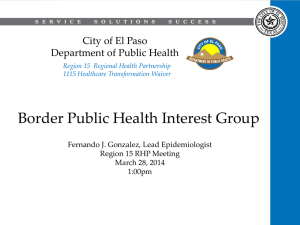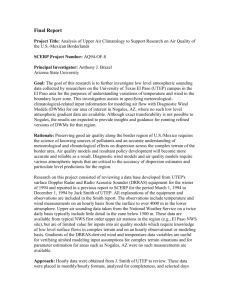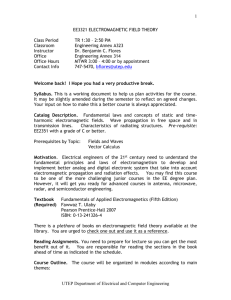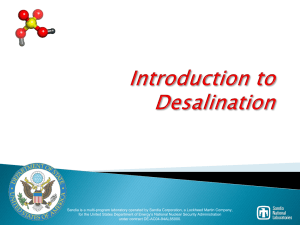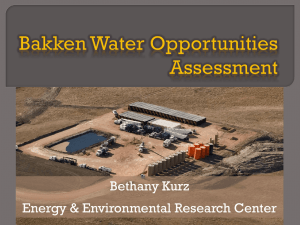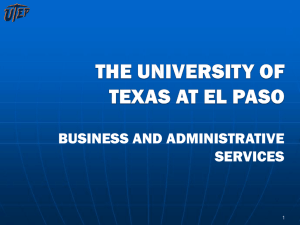Concentrate and permeate treatment processes for improving the
advertisement
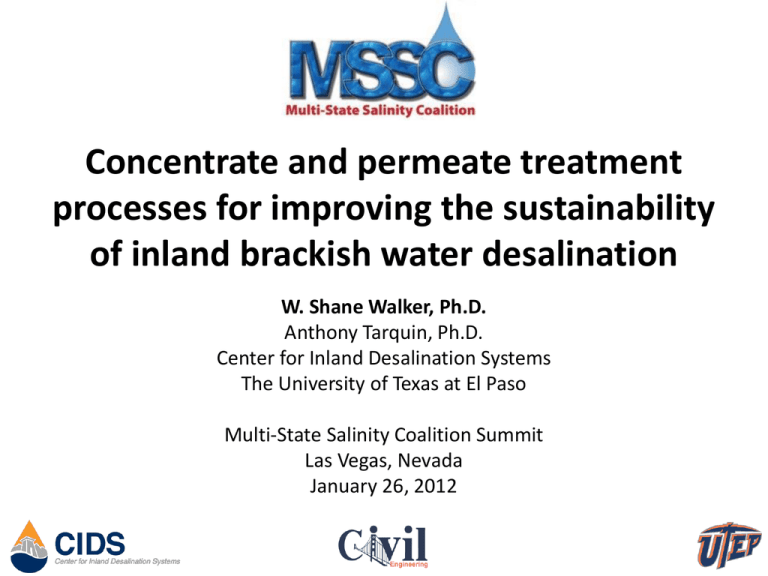
Concentrate and permeate treatment processes for improving the sustainability of inland brackish water desalination W. Shane Walker, Ph.D. Anthony Tarquin, Ph.D. Center for Inland Desalination Systems The University of Texas at El Paso Multi-State Salinity Coalition Summit Las Vegas, Nevada January 26, 2012 Objectives • Review indicators of sustainability • Highlight several CIDS investigations demonstrating improved sustainability Sustainability Environmental SocioPolitical Economic Select Sustainability Indicators • • • • • Higher water recovery (product/feed) Environmental Lower specific energy consumption (kWh/kgal) Less chemical consumption, waste production Lower economic cost ($/kgal; $/MGD) SocioTechnical/operational complexity Economic Political Inland Membrane Desalination pretreatment membrane process Brackish Water Source permeate treatment Distribution concentrate treatment Reuse/Disposal Permeate Treatment pretreatment membrane process Brackish Water Source permeate treatment Distribution concentrate treatment Disposal Permeate Stabilization by Calcite Carollo Engineers, Inc. and Shane Walker, UTEP Texas Water Development Board (1004831105) Three-step process 1. Lower pH with CO2 – Relatively abundant and inexpensive gas 2. CO2 reacts with calcite – CO2 + CaCO3 → Ca2+ + 2 HCO3- 3. Add small dose of base for LSI > 0 Permeate Stabilization by Calcite Carollo Engineers, Inc. and Shane Walker, UTEP CIDS Texas Water Development Board (1004831105) • Feed: KBH permeate • TOMCO2: pH 5.6-5.7 • Upflow calcite contactor – Media: 0.5-2 mm particles – EBCT: 1-10 min – Overflow: 2-17 gal/ft2/min • Product Quality: – – – – pH: 7.5-8.5 Ca2+: 20-30 mg/L ALK: 50-75 mg/L (as CaCO3) LSI: -0.5-0.0 • Energy: < 0.1 kWh/kgal Concentrate Treatment pretreatment membrane process Brackish Water Source permeate treatment Distribution concentrate treatment Disposal CERRO Anthony Tarquin, UTEP US Bureau of Reclamation, DWPR R10AP81217 • Concentrate Enhanced Recovery RO (CERRO) • Batch-continuous seawater RO process exploiting induction time of precipitation concentrate Seawater RO Distribution CERRO Anthony Tarquin, UTEP US Bureau of Reclamation, DWPR R10AP81217 • Demonstrated at KBH (El Paso) and BGNDRF (Alamogordo) • Feed: KBH- >10,000 mg/L BGNDRF- 6000 mg/L • Product Flow: 1 gpm • Recovery: KBH- 97% BGNDRF (ongoing) • Energy: 6-7 kWh/kgal (w/ energy recovery) Zero Discharge Desalination (ZDD) Tom Davis & Malynda Cappelle, UTEP US Bureau of Reclamation, DWPR R10AP81212 • Demonstrated at KBH (El Paso) and BGNDRF (Alamogordo) • BGNDRF Feed: 2500 mg/L • NF/RO and Electrodialysis Metathesis (EDM) • Product Flow: 20 gpm • Recovery: 97-98% • Energy: 6.6 kWh/kgal Conclusions Sustainability of inland brackish water desalination can be improved by: – increasing system recovery – reducing specific energy consumption – reducing chemical consumption and production – reducing economic cost – designing appropriate technical complexity Acknowledgements • Permeate Stabilization by Calcite – – – – Texas Water Development Board El Paso Water Utilities, KBH Desalination Plant Carollo Engineers: Winnie Shih, Bradley Sessions, Justin Sutherland UTEP CIDS: Luis Maldonado, Cora Martinez, Sami Al-Haddad • CERRO (High Recovery) – US Bureau of Reclamation, BGNDRF (Alamogordo, NM) – UTEP CIDS: Anthony Tarquin, Guillermo Delgado • ZDD (High Recovery) – US Bureau of Reclamation, BGNDRF (Alamogordo, NM) – UTEP CIDS: Tom Davis, Malynda Cappelle, Lucy Camacho, Noe Ortega, Jesse Valles Questions or Comments W. Shane Walker, Ph.D. Assistant Professor The University of Texas at El Paso 500 W. University Ave., Civil Engineering El Paso, TX 79968 (915) 747-8729 wswalker2@utep.edu


